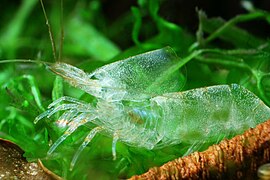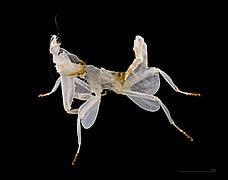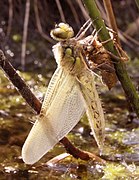Exuvie

The Exuvie (also exuvia of lat . Exuviae , stored (animal) skin ', shirt', 'empty shell') is in the molting ( Ecdysis stripped) skin of molting animals ( ecdysozoan ) or reptiles ( Reptilia ). In connection with reptiles, however , the term exuvie is rarely used. The exuvia consists of the chitin and sclerotin- containing exoskeleton of molting animals or the horny horny scales of reptiles ( called scuta ) and sometimes also has cuticular structures such as scales or bristles. Exuviae are found mainly in arthropods ( Arthropoda ) such as insects , arachnids and crustaceans , but also in the lower land vertebrates , such as snakes (as snake Shirt or "Schlangenbalg") and lizards .
The adder shirt consists of the old horn (cell) layer ( stratum corneum ), the outermost layer of the epidermis , consisting of dead cells, which is usually stripped off in one piece with the inside out .
The gap between the old and newly forming cuticula that arises during the preparation of the molting of arthropods is called the exuvial space. In these, the animal releases a secretion ( exuvial fluid ) consisting mainly of chitinases and proteinases , which dissolves the old endocuticle from the inside.
In the case of trilobites , horseshoe crabs and sea scorpions , exuvia also form important fossils , since most of the fossils of these animal groups found are not the animals themselves, but, due to the numerous growth-related moults, mostly their moulting remains.
Individual evidence
- ↑ Klaus Kabisch: Dictionary of Herpetology . VEB Gustav Fischer Verlag Jena, 1990 ,. P. 302.
- ↑ Lexikon der Biologie , Vol. 3. Herder, Freiburg 1984, ISBN 3-451-19643-3 .
Web links
Stripped Chitin Shell of Yamatonuma Shrimp ( Yamato numaebi )
Larval skin of leafhopper Lyristes plebejus
The remnants of a tarantula
Stripped carapace of a juvenile horseshoe crab , view ventral
"Natter Shirt" a grass snake
A quadrangle shortly after hatching .








